Related Research Articles
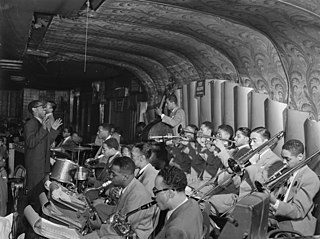
The Savoy Ballroom was a large ballroom for music and public dancing located at 596 Lenox Avenue, between 140th and 141st Streets in the Harlem neighborhood of Manhattan, New York City. Lenox Avenue was the main thoroughfare through upper Harlem. Poet Langston Hughes calls it the "Heartbeat of Harlem" in Juke Box Love Song, and he set his work "Lenox Avenue: Midnight" on the legendary street. The Savoy was one of many Harlem hot spots along Lenox, but it was the one to be called the "World's Finest Ballroom". It was in operation from March 12, 1926, to July 10, 1958, and as Barbara Englebrecht writes in her article "Swinging at the Savoy", it was "a building, a geographic place, a ballroom, and the 'soul' of a neighborhood". It was opened and owned by white entrepreneur Jay Faggen and Jewish businessman Moe Gale. It was managed by African-American businessman and civic leader Charles Buchanan. Buchanan, who was born in the British West Indies, sought to run a "luxury ballroom to accommodate the many thousands who wished to dance in an atmosphere of tasteful refinement, rather than in the small stuffy halls and the foul smelling, smoke laden cellar nightclubs ..."
An Aerial is a dance move in Lindy Hop or Boogie Woogie where one's feet leave the floor. As opposed to a lift, aerial is a step where a partner needs to be thrown into the air and then landed in time with the music. Each aerial consists of a preparation ('prep'), jump or trick itself and the landing.

Swing dance is a group of social dances that developed with the swing style of jazz music in the 1920s–1940s, with the origins of each dance predating the popular "swing era". Hundreds of styles of swing dancing were developed; those that have survived beyond that era include Lindy Hop, Balboa, Collegiate Shag, and Charleston. Today, the best-known of these dances is the Lindy Hop, which originated in Harlem in the early 1930s. While the majority of swing dances began in African-American communities as vernacular African-American dances, some influenced swing-era dances, like Balboa, developed outside of these communities.
The Big Apple is both a partner dance and a circle dance that originated in the Afro-American community of the United States in the beginning of the 20th century.
This is a list of movies featuring recognizable dance forms, demonstrating them, shedding light on their origin, or being the base of a plot.

Jitterbug is a generalized term used to describe swing dancing. It is often synonymous with the lindy hop dance but might include elements of the jive, east coast swing, collegiate shag, charleston, balboa and other swing dances.

Frank Manning was an American dancer, instructor, and choreographer. Manning is considered one of the founders of Lindy Hop, an energetic form of the jazz dance style known as swing.

The Hot Shots is a collective name for two closely related Swedish dance companies based in Stockholm, Sweden: The Rhythm Hot Shots and the Harlem Hot Shots. The Hot Shots specialize in faithful reproductions of African-American dance scenes in American films from the 1920s, 30s, and 40s. Dances that they perform include Lindy Hop, Tap dance, Cakewalk, Charleston, and Black Bottom. The members of the Hot Shots are also respected dance instructors and accomplished social dancers. The goals of The Rhythm Hot Shots and the Harlem Hot Shots are the same.
Whitey's Lindy Hoppers was a professional performing group of exceptional swing dancers that was first organized in the late 1920s by Herbert "Whitey" White in the Savoy Ballroom and disbanded in 1942 after its male members were drafted into World War II. The group took on many different forms and had several different names and sub-groups, including Whitey's Hopping Maniacs, Harlem Congeroo Dancers, and The Hot Chocolates. In addition to touring nationally and internationally, the group appeared in several films and Broadway theatre productions. Dorothy Dandridge and Sammy Davis Jr. were among the group's celebrity regulars.
Al Minns, was a prominent American Lindy Hop and jazz dancer. Most famous for his film and stage performances in the 1930s and 1940s with the Harlem-based Whitey's Lindy Hoppers, Minns worked throughout his life to promote the dances that he and his cohorts helped to pioneer at New York's Savoy Ballroom.
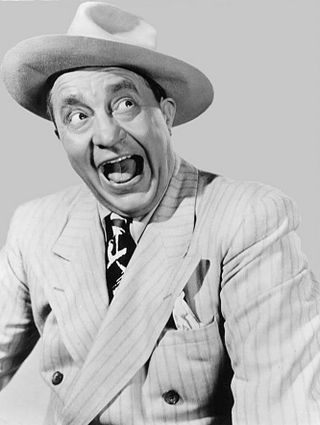
Harold Ogden "Chic" Johnson was the barrel-chested half of the American comedy team of Olsen and Johnson, known for his strangely infectious, high-pitched "Woo-Woo" laugh.

The history of Lindy Hop begins in the African American communities of Harlem, New York during the late 1920s in conjunction with swing jazz. Lindy Hop is closely related to earlier African American vernacular dances but quickly gained its own fame through dancers in films, performances, competitions, and professional dance troupes. It became especially popular in the 1930s with the upsurge of aerials. The popularity of Lindy Hop declined after World War II, and it converted to other forms of dancing, but it never disappeared during the decades between the 1940s and the 1980s until European and American dancers revived it starting from the beginning of the 1980s.
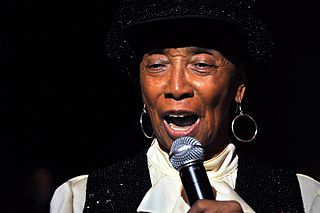
Norma Adele Miller was an American Lindy hop dancer, choreographer, actress, author, and comedian known as the "Queen of Swing".
The Congaroos was a dance group created in 1947 by Frankie Manning after completing his military service for World War II. The group originally consisted of Frankie Manning dancing with Ann Johnson and Russell Williams dancing with Willamae Ricker. Later Helen Daniels joined the group and partnered Frankie Manning. The group performed Lindy Hop, Conga, jazz dance, tap dance, Latin dances, and comedy with musicians and vocalists such as Alvino Rey, Lucky Millinder, Illinois Jacquet, Ella Fitzgerald, Count Basie, Erskine Hawkins, Andy Kirk, Fletcher Henderson, and Cab Calloway.
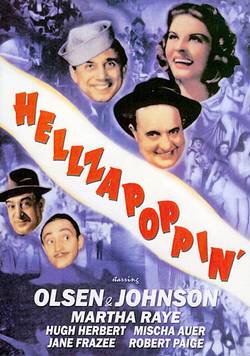
Hellzapoppin' is a 1941 American musical comedy film, and an adaptation of the stage musical of the same name that ran on Broadway from 1938 to 1941. The film is directed by H. C. Potter and distributed by Universal Pictures. Although the entire Broadway cast was initially slated to feature in the film, the only performers from the stage production to appear in the film were lead actors Ole Olsen and Chic Johnson, and the specialty act Whitey's Lindy Hoppers.
"Jumpin' at the Woodside" is a song first recorded in 1938 by the Count Basie Orchestra, and considered one of the band's signature tunes. When first released it reached number 11 on the Billboard charts and remained on them for four weeks. Since then, it has become a frequently recorded jazz standard.

The Spirit Moves: A History of Black Social Dance on Film, 1900–1986 is a documentary film by Mura Dehn chronicling the evolution of African-American social dance throughout most of the 20th century. In its original form it consists of nearly six hours of rare archival footage shot over the course of thirty years. Since 1987 this complete version has only been available for viewing at a select few institutions. In 2008 the first three parts of Dehn's work, totaling two hours, were remastered and released on DVD by Dancetime Publications.
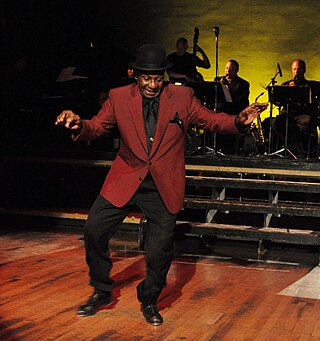
Charles "Chazz" Young is an American choreographer and teacher of tap dance.

The Lindy Hop is an American dance which was born in the Black communities of Harlem, New York City, in 1928 and has evolved since then. It was very popular during the swing era of the late 1930s and early 1940s. Lindy is a fusion of many dances that preceded it or were popular during its development but is mainly based on jazz, tap, breakaway, and Charleston. It is frequently described as a jazz dance and is a member of the swing dance family.
Leon James was a prominent American Lindy Hop and jazz dancer. A performer during the 1930s and 1940s with the Harlem-based Whitey's Lindy Hoppers, he and his partner Willa Mae Ricker were featured in a photo essay in the August 23, 1943, issue of Life magazine, demonstrating air steps.
References
- 1 2 Wheaton, Anthony. "Frankie and his Partners".
- 1 2 3 White, Bobby (2011-04-05). "Willa Mae Ricker, the patron saint of respect for Lindy Hoppers (ISDFNOKA #3)". Archived from the original on 2020-06-11.
- 1 2 3 4 Pritchett, Judy; Manning, Frank. "Willa Mae Ricker".
- ↑ "Willa Mae Ricker". IMDB.
- ↑ Stevens, Tamara (April 7, 2011). Stevens, Erin (ed.). Swing Dancing. ABC-CLIO. p. 110.